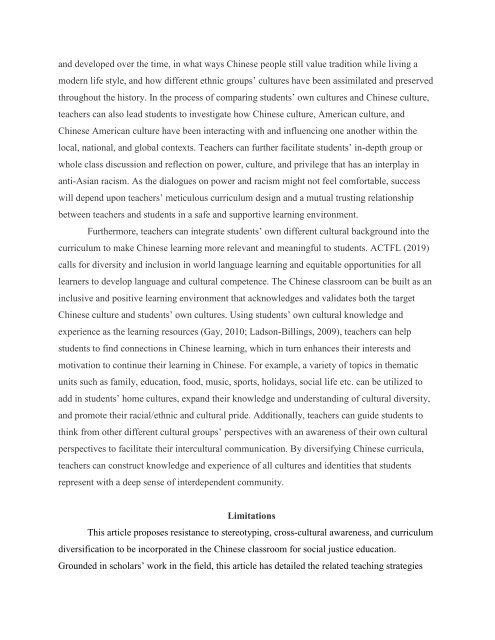K-12 Chinese Language Teaching, Issue 5
The K-12 CLT focuses on sharing experiences and exchanging ideas in teaching, research, and professional development.
The K-12 CLT focuses on sharing experiences and exchanging ideas in teaching, research, and professional development.
You also want an ePaper? Increase the reach of your titles
YUMPU automatically turns print PDFs into web optimized ePapers that Google loves.
and developed over the time, in what ways <strong>Chinese</strong> people still value tradition while living a<br />
modern life style, and how different ethnic groups’ cultures have been assimilated and preserved<br />
throughout the history. In the process of comparing students’ own cultures and <strong>Chinese</strong> culture,<br />
teachers can also lead students to investigate how <strong>Chinese</strong> culture, American culture, and<br />
<strong>Chinese</strong> American culture have been interacting with and influencing one another within the<br />
local, national, and global contexts. Teachers can further facilitate students’ in-depth group or<br />
whole class discussion and reflection on power, culture, and privilege that has an interplay in<br />
anti-Asian racism. As the dialogues on power and racism might not feel comfortable, success<br />
will depend upon teachers’ meticulous curriculum design and a mutual trusting relationship<br />
between teachers and students in a safe and supportive learning environment.<br />
Furthermore, teachers can integrate students’ own different cultural background into the<br />
curriculum to make <strong>Chinese</strong> learning more relevant and meaningful to students. ACTFL (2019)<br />
calls for diversity and inclusion in world language learning and equitable opportunities for all<br />
learners to develop language and cultural competence. The <strong>Chinese</strong> classroom can be built as an<br />
inclusive and positive learning environment that acknowledges and validates both the target<br />
<strong>Chinese</strong> culture and students’ own cultures. Using students’ own cultural knowledge and<br />
experience as the learning resources (Gay, 2010; Ladson-Billings, 2009), teachers can help<br />
students to find connections in <strong>Chinese</strong> learning, which in turn enhances their interests and<br />
motivation to continue their learning in <strong>Chinese</strong>. For example, a variety of topics in thematic<br />
units such as family, education, food, music, sports, holidays, social life etc. can be utilized to<br />
add in students’ home cultures, expand their knowledge and understanding of cultural diversity,<br />
and promote their racial/ethnic and cultural pride. Additionally, teachers can guide students to<br />
think from other different cultural groups’ perspectives with an awareness of their own cultural<br />
perspectives to facilitate their intercultural communication. By diversifying <strong>Chinese</strong> curricula,<br />
teachers can construct knowledge and experience of all cultures and identities that students<br />
represent with a deep sense of interdependent community.<br />
Limitations<br />
This article proposes resistance to stereotyping, cross-cultural awareness, and curriculum<br />
diversification to be incorporated in the <strong>Chinese</strong> classroom for social justice education.<br />
Grounded in scholars’ work in the field, this article has detailed the related teaching strategies


